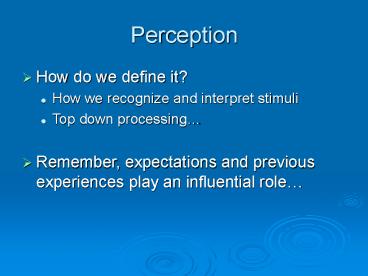Perception - PowerPoint PPT Presentation
1 / 44
Title:
Perception
Description:
Motion Perception Phi Phenomenon Troxler Effect With loss of sight- motion is usually first to be ... Constancy We see objects as having consistent color, ... – PowerPoint PPT presentation
Number of Views:187
Avg rating:3.0/5.0
Title: Perception
1
Perception
- How do we define it?
- How we recognize and interpret stimuli
- Top down processing
- Remember, expectations and previous experiences
play an influential role
2
(No Transcript)
3
(No Transcript)
4
(No Transcript)
5
(No Transcript)
6
Selective Attention
- Our senses can take in approximately 11,000 bits
of information at a time - BUT
- We can only focus on one thing at a time
7
Neissers Basketball Study
- Inattentional Blindness
- Focusing on one stimulus prevents us from
noticing others - The dancing gorilla (bear)
- Texting and driving!
8
2 readers, one listener.
- Cocktail Party Effect
- Can listen to only one voice at a time
- Can notice gender
- Can detect name
9
Just how much do we notice?
- Change blindness
- We fail to notice changes in our environment
(when we are focusing on something else)
10
Pop Outs!
- Striking distinctions grab our attention
11
Perceptual Illusions
- Mislead us by playing on the way we organize and
interpret our sensations - (challenges our schema!)
- Reveal how we normally organize our sensations
(thus clues to mechanisms of perception) - Visual Capture Vision is our dominant sense
(effects how we perceive our other senses) - McGurk Effect (Youtube/edu)
12
(No Transcript)
13
(No Transcript)
14
(No Transcript)
15
(No Transcript)
16
(No Transcript)
17
(No Transcript)
18
Perceptual Organization
- Visual Agnosia
- See all parts of an image, but not the whole, (or
meaning)
19
Gestalt (form)
- The whole is greater than the sum of its parts
- We tend to see, or group images as a whole, not
as individual or isolated parts - A natural, or innate form of perception
20
Gestalt (How we group objects)
- Figure and ground (sometimes can be reversible)
21
Gestalt
- Proximity
22
Gestalt
- Similarity
23
Gestalt
- Continuity
24
Gestalt
- Closure
25
Depth Perception
- Binocular Cues (interplay of two eyes)
- Retinal Disparity each eye sees object from
slightly different angle (brain computes
difference in vision to judge depth) - Convergence eyes move together as item gets
closer (brain detects convergence of eyes as
measure of depth) - The Finger Sausage!
26
Depth Perception
- Monocular Cues
- Relative Size
27
Monocular Cues
- Linear perspective
28
Monocular Cues
- Texture gradient
29
Monocular Cues
- Interposition
30
Monocular Cues
- Relative Height
31
Monocular Cues
- Relative Clarity
32
Monocular Cues
- Relative Motion (The faster it moves)
33
Monocular Cues
- Light and Shadow
34
Motion Perception
- Phi Phenomenon
- Troxler Effect
- With loss of sight- motion is usually first to be
restored
35
Perceptual Constancy
- Perceiving an object as unchanging despite a
change in stimulus - Key factors Experience, Expectation (Rules of
perception) - Size Constancy
- As stimulus changes, we literally see changing
size, but we know size has not changed due to
experience and context of objects surroundings
36
Size Constancyhttp//www.eruptingmind.com/depth
-perception-cues-other-forms-of-perception/
37
Shape Constancy
- We know shape is constant even though our angle
and thus vision of object changes
38
Lightness (Color) Constancy
- We see objects as having consistent color, even
as changing conditions alter the wavelength
reflecting off the object.
http//www.psy.ritsumei.ac.jp/akitaoka/light5e.ht
ml
39
Perceptual Set
- To believe it is to see it
- A mental predisposition
- Experiences give us a perceptual set, or
assumptions that influence how or what we see
40
Context Effect
- The context in which a stimulus appears affects
how we perceive it - eel is on the wagon.
- eel is on the orange.
41
Sensory Deprivation / Restored Vision
- Adults with vision for first time (cataract
surgery) - Have Sense of colors, detect figure from ground
- No depth perception, no perceptual constancy
(cortical cells not developed) - Much of perception is learned during critical
period in early development
42
Perceptual Adaptation
- Our perception can adapt to change in stimuli,
environment - Inverted goggles!!
43
Perceptual Constancypages 250-262
- Shape constancy
- Size constancy
- Light constancy
44
- Sensory Deprivation and Restored Vision
- Perceptual Adaptation
- Perceptual Set
- Context Effects































